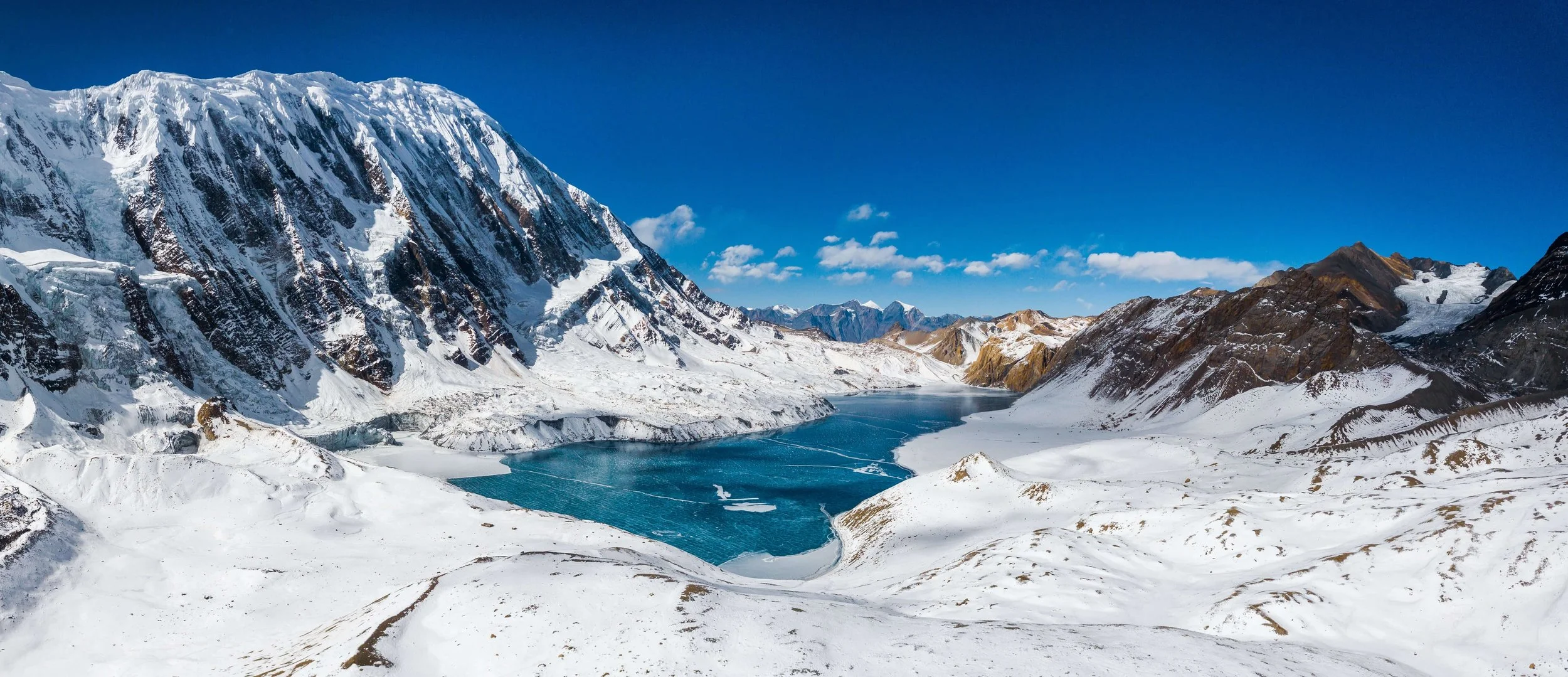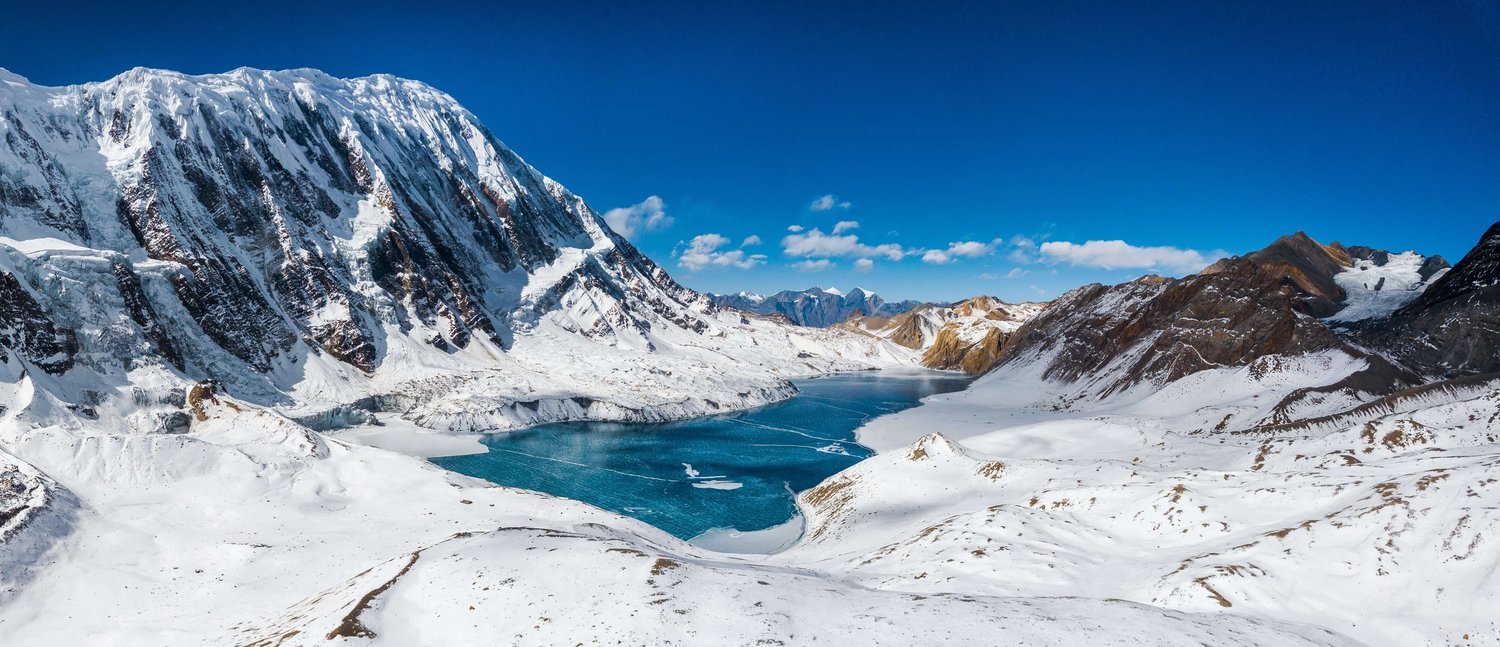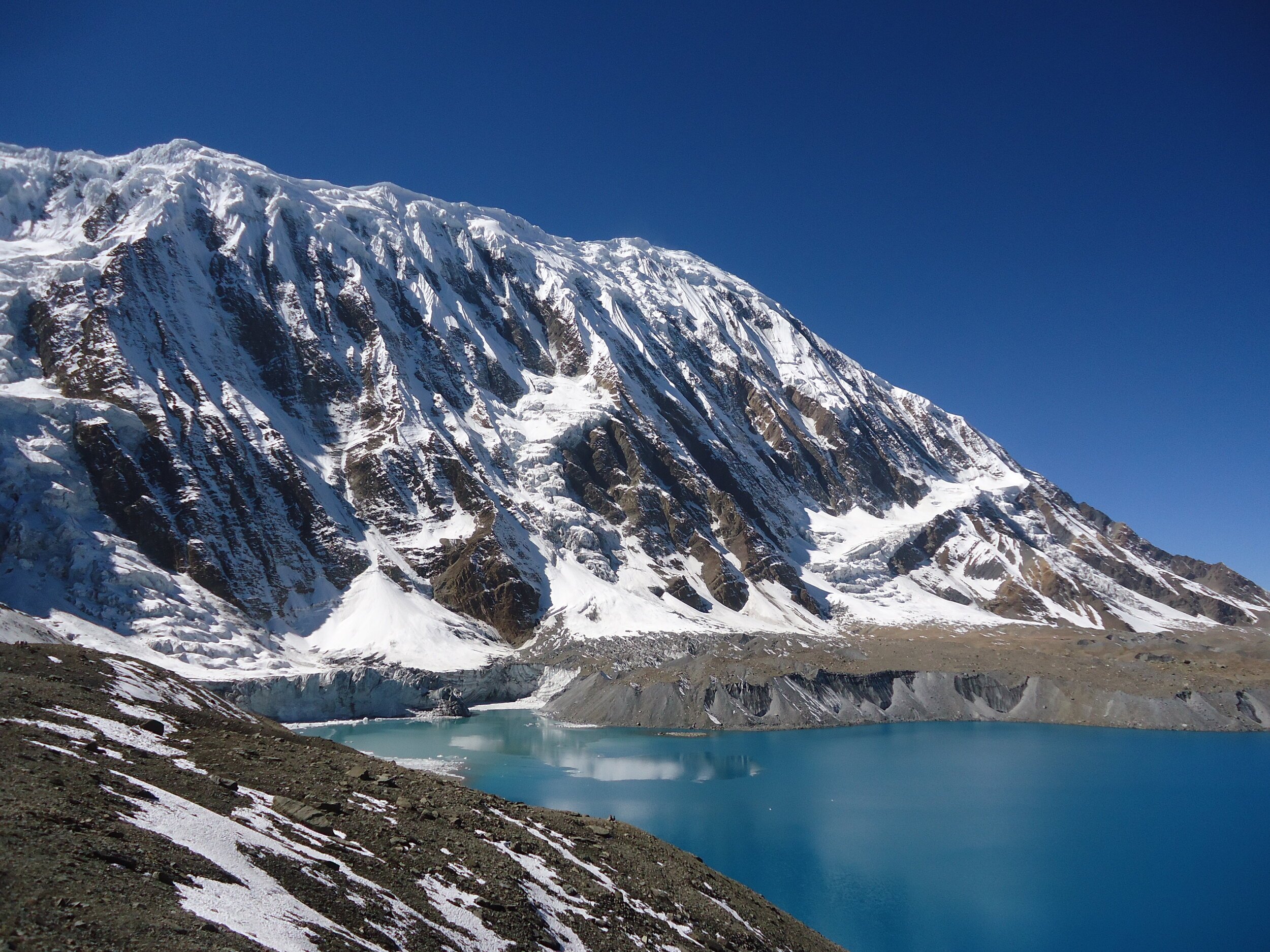
tilicho expedition 7134m
HIGHLIGHTS
Tilicho 7134M summit, part of Annapurna massif
2026 Expedition. Namas Chief Adventurer/founder to lead the expedition.
Intermediate level 7000M+ expedition
1:1 Guide/Client support ratio. Small team strategy. 3 - 10 max client members
North-West Shoulder Ridge route, Camp 1, 2, and 3 strategy
7 - 14 days in Tilicho Base Camp 4910M and higher
16 Weeks of training programs for 7000M from Training Peaks
Base camp by picturesque Tilicho lake 4900M, Annapurna 1,2,3, AIV Gangapurna seen from Summit
OVERVIEW
Tilicho Peak 7134M offers a challenging yet rewarding climb for those seeking technical ascents in the 7000M peak range. The expedition commences with a picturesque trek through the Annapurna circuit, culminating at the breathtaking Tilicho Lake, situated at an altitude of 4910M, the highest lake in the world.
This majestic peak is positioned to the north of Manang within the Annapurna Region, standing tall at an elevation of 7134m. Its northeast ridge, adorned with snow, commands a striking presence, overlooking the high Kali Gandaki valley to the west and the Marshyangdi Valley to the east. Just a stone's throw away lies the concealed realm of Mustang in the north.
The standard climbing route runs along the northwest shoulder, with the Base Camp (4800m) nestled at the lake's northwest extremity. With relatively fewer climbers in the Annapurna mountain range, adventurers can relish the awe-inspiring landscape almost exclusively to themselves.
-
Autumn 2026
3rd - 28th November - Signature Climb
1st - 29th November - Classic Climb
Autumn 2027
18th October - 12th November - Signature Climb
16th October - 12th November - Classic Climb
"Minimum 4 members required"
For private climb please inquire
-
USD 19,900 P/P - Signature Climb
USD 12,500 P/P - Classic Climb
Deposit : USD 1,500 P/P
Please inquire about prices in your local currency. We accept payment in £GBP/ €EUROS/ $AUD
-
IFMGA/NMA certified Guide leader
Nama branded merchandise (Down Jacket, Cap, Buff)
1:1 Sherpa/client ratio. (Additional Sherpa can be arranged, extra charges apply)
16 Weeks of training programs for 7000M from Training Peaks
Head chef and kitchen helpers (Helpers increase with the number of climbing team members)
2 nights before the expedition and 1 day after the expedition. Hotel in Kathmandu. Single executive room. (Should clients return early from their expedition, clients will be responsible for their extra Kathmandu hotel bookings)
All trekking and climbing permits (Annapurna Region Permit and TIMS)
All internal-local transportation to and from the trekking trailhead
Expedition tents (2 or 1-person tents) Brands Salewa, Mountain Hardwear, Samaya equipment, Kailas
40 kgs personal weight (Extra additional weight, clients will need to hire an additional porter. Estimated $1000 USD for 26 - 28 Days)
Chocolate, energy bars, hydration pills, biscuits, canned foods, nuts
Burners and expedition equipment
Walkie-talkie/ Satellite phone
Breakfast, Lunch, and Dinner on trek and expedition days.
Lodge accommodation during the trek
Porters per guest
Arrival pick-up and departure
Basic First aid kit
Welcome/Farewell leave Dinner
-
Visas and travel insurance
Summit Tips (USD 1000+ Per member)
Entertainment and food ( Kathmandu )
Bottled drinks and beverages
Evacuation (will be done in your account)
Single supplement Charges
Laundry, Phone services, Personal expenditure transactions
Optional trips
Tea breaks, chocolates or other snacks, and any meals besides breakfast, lunch, and dinner.
Delay and cancellation because of natural phenomenon
International flights to Kathmandu
-
Helicopter from Tilicho BC to Pokhara USD 4550 (3 passengers)
Supplemental oxygen USD 550 (Full set)
Additional Local Sherpa guide USD 4000
-
150 Summits
ITINERARY - Signature climb
Day 1 Kathmandu
Day 2 Gear check final preparations
Day 3 🚁 Heli Kathmandu - Manang 3500M
Day 5 Acclimatisation Day
Day 6 Tilicho base camp
Day 7 - 22 Climbing period (Puja day, Rotation to camp 1,2 and 3, Summit push and contingency days)
Day 23 - 24 🚁 Tilicho Lake 4900M - Kathmandu (may include Shuttle flights). Drive to Nagarkot - NAMAS Signature Reset & Recover
Day 25 Kathmandu
Day 26 Departure
-
Day 1 Kathmandu
Day 2 Gear check final preparations
Day 3 Kathmandu - Besisahar (Via Jeep)
Day 4 Besi Sahar to Humde (Via Jeep)
Day 5 Manang (Trek 6 hours)
Day 6 Acclimatisation Day
Day 7 Tilicho base camp
Day 8 - 23 Climbing period (Puja day, Rotation to camp 1,2 and 3, Summit push and contingency days)
(Tilicho climb express, fly from Tilicho base camp to Pokhara directly - please inquire with our team)
Day 24 Tilicho Lake 4900M to Mesokanta la pass 5100M - Yak Kharka
Day 25 Trek to Jomsom
Day 26 Jomsom to Pokhara(via flight, incase of disruption cancellation via jeep)
Day 27 Rest day in Pokhara
Day 28 Flight Pokhara to Kathmandu
Day 29 Departure
-
Day 23 — Physical Reset & Nervous-System Downshift
Arrival - Silent check-in & welcome ritual (no briefings, no schedules)
Deep tissue / sports recovery massage (60–90 mins) - Focus: calves, quads, hips, lower back, shoulders
Infrared or traditional sauna session
Guided breath work session (20–30 mins) - Helps shift from survival mode to recovery mode
Day 24 — Mental Closure & Gentle Reawakening
Slow wake-up with sunrise Himalayan views
Guided mindfulness or reflection session → closing the climb mentally, not just physically
Foot therapy / reflexology and Facial
Guided breath-work session (20–30 mins) - Helps shift from survival mode to recovery mode
-
🚁 Heli Kathmandu - Manang: USD 4200
🚁 Tilicho BC - Kathmandu: USD 5300
Chulu Far East - USD 3900
Ama Dablam 6812M - USD 8500 (Signature climb), USD 7900 (Classic Climb)
Annapurna IV, 7525M - USD 10,500
BLOG ARTICLES
TECHNICALITY & DIFFICULTY
This expedition is categorized as D+ and involves a blend of rock and ice climbing along with glacier traverses. The climb includes the establishment of three high camps en route to the summit. The ascent from Base Camp to Camp 1 (5800m) follows a straightforward 590m route along a 50-degree mixed rock and ice shelf below the Northwest shoulder.
Camp 2 (6200m) sits atop the shoulder and is accessed via a 450m stretch of 55-degree snowfields. The 55-degree angled shoulder boasts an 800m snowfield with low objective danger and minimal exposure due to its substantial width. Climbing Tilicho Peak with fixed ropes is necessary on a 40-degree slope to reach Camp II at 6300m, followed by stretches of 60-degree slopes approaching the summit.
The base camp for Tilicho Peak is established in the vicinity of the lake. A rest day is scheduled at the base camp, during which a ceremonial Puja is conducted by a Buddhist priest. This ritual is performed to seek blessings from the sacred mountains for our climb. Following the Puja, we embark on our climb, blessed and prepared. Our journey to Tilicho 7,134m begins from the Base Camp, situated at approximately 4400m altitude.
Base Camp to Camp (I) - steep 70º/90º
Camp (I) to Camp (II) - steep 90º with ice vertical.
Camp (II) to Camp (III) - 40º/ 60º or Max. 70º
*History - Tilicho Peak was first climbed by a French expedition led by Emanuel Schmutz in 1978 via the North West Shoulder.





HOW DOES IT WORK?
1. Initial Inquiry and Planning
At NAMAS Adventure, we start by understanding your aspirations and goals. From your first conversation with our expert team, we provide personalized recommendation tailored to your interests. Once the perfect expedition is identified, a deposit secures your spot. We then work closely with you to plan and prepare every detail—from gear selection and training advice to arranging insurance, permits, and logistics.
2. Preparing for the Journey
As your expedition date approaches, we’ll help you finalize all preparations. This includes collecting the final balance payment (typically due 60-90 days before your trip), ensuring all necessary documents are in order, and addressing any remaining questions. Our team is available via email or phone calls to make sure you’re fully prepared and confident for the adventure ahead.
3. On-Expedition Support
Arrive at your destination ready to begin! From pre-expedition briefings and gear checks to the full support of our experienced guides and ground team during your climb, we’re here to ensure everything runs smoothly. With flexibility to adapt to any changes or needs, we’re committed to making your adventure seamless, enjoyable, and unforgettable

Frequently Asked Questions
About the Mountain
-
Tilicho peak is a stunning 7134-meter peak located in the western Himalayas of Nepal, part of the Annapurna massif. This remote peak sits just above the beautiful Tilicho lake and from the summit Annapurna 1 and Annapurna IV are clearly visible.
Tilicho is often approached via Annapurna circuit offering a remote and wild expedition route. It is a remote and no crowd faily technical climbing route, combined with high altitude, glacier travel, and exposure, makes it a popular 7000-meter peak for mountaineers preparing for 8000ers like Everest or Makalu.
-
The best time to climb Tilicho is:
Autumn (Late Sept–Nov): Clear skies, stable weather, and safe climbing conditions. Most recommended.
Spring (Late April– May): Warmer temperatures and ideal for those preparing for Everest or other 8000ers. This is when the window opens for Everest and Makalu summits too.
Avoid monsoon (June–Aug) and winter (Dec–Feb) due to poor weather and high avalanche risk.
-
We will ascend Tilicho Peak via the Northwest Route, following the rocky ridge section and establishing three higher camps. The route features rocky terrain from Base Camp to Camp 1, then transitions into mixed ice and snow sections leading to the summit.
Our rope-fixing team will set fixed lines all the way to the summit for maximum safety. The expedition uses Camp 1 - 3 with a well-planned acclimatization and climbing strategy to ensure a safe and successful ascent.
-
Tilicho is considered a semi-technical 7000M peak, making it ideal for climbers with previous 6000M experience. This expedition is graded at itermediate level grades.
The climb to camp 1 is mostly on rocky terrain and camp 2-3 is mostly mixed climbing to the summit.
Proper acclimatization, prior high-altitude experience, and good fitness are essential.
-
Summit day on Tilicho begins early in the morning with a steady, straightforward climb along a narrow snow and ice ridge. The route is fully fixed with ropes for safety. Depending on conditions, climbers typically return to Camp 2 or Camp 1 the same day after summiting.
-
Yes, we’ve included 7 contingency days within the 16-day climbing period to account for weather delays or other unforeseen factors. In ideal conditions, the summit push from Base Camp and return can be completed in 5 days.
However, the added buffer allows flexibility for a safe and successful summit attempt.
Experiences - preprations
-
Tilicho is a semi-technical 7000M climb, but it still requires strong motivation and a solid foundation in mountaineering. If you’re unsure whether this is the right step in your climbing journey, we recommend reviewing our grading system Alpine / Fitness grading: AD+ / 4to assess your readiness.
Still uncertain? Reach out to our team — we’re happy to help evaluate your experience and guide you toward the expedition that best fits your goals.
-
You’ll need prior high-altitude mountaineering experience, ideally on alpine AD-grade routes. Climbers must be confident using fixed ropes, crampons, ice axe, and jumar on steep rock and ice while carrying a loaded pack.
If you’re unsure whether your experience is sufficient, feel free to reach out — we’ll be happy to assess your readiness and recommend the right training or preparatory climbs.
-
Yes, Tilicho peak requires solid technical skills. You should be comfortable climbing on steep rock and ice using crampons, ice axe, fixed ropes, and jumars. Although fixed lines are in place to assist, prior experience on technical alpine routes is essential for safety and success.
If you need guidance on developing these skills, please contact us for advice and training recommendations.
-
To prepare for Tilicho peak, focus on building endurance, strength, and technical climbing skills, including ice axe and crampon use, rope techniques, and high-altitude acclimatization.
When you book with Namas Adventure, you’ll receive a comprehensive 16-week personalized training program via TrainingPeaks, designed by professional trainers to ensure you’re fully prepared for the expedition.
-
For the expedition, Namas Adventure allows a personal baggage limit of 40 kg.
During trekking: You’ll carry your personal items like camera, snacks, water, waterproof or down jackets — typically around 2–5 kg.
On the way to higher camps: You’ll carry more essential gear such as your sleeping bag, boots, sleeping pad, snacks, and down suit, totaling about 10–12 kg.
Summit push: Your pack will be lighter, carrying just water, snacks, and essential gear for the climb.
-
During trekking, we stay at local Sherpa tea houses that offer a warm cultural experience. These lodges are tidy, clean, and among the best available in each village, thanks to our strong relationships with owners.
Rooms: Standard trips include shared rooms (usually twin or sometimes triple share). Private rooms may be available at an additional cost. There are limited tea house in so finding single room during peak season will be challenging.
On the mountain: You will share tents with one or two other climbers.
Base Camp: Personal tents are available.
-
On trekking days, the tea houses we stay at offer hot showers and laundry services for a small fee. At Base Camp, we set up shower tents with hot water available for washing clothes. Laundry powder is provided for your convenience.
-
Yes, all our expeditions are all-inclusive. Breakfast, lunch, dinner, and ample hot and cold drinks during trekking and expedition days are included. We can accommodate vegetarians and many special diets if informed in advance. Expect excellent local and Western cuisine.
-
During trekking, meals at tea houses are menu-based and include local staples like rice and lentils (dal bhat), as well as pasta, soups, pizza, dumplings, and more.
On higher camps days, we provide basic cooked meals such as noodles, soup, museli, biscuits, chocoaltes etc.
We recommend you to get your personal dried freezed meals in Kathmandu for your include rice, lentils, vegetables, pasta, freeze-dried meals (chicken, veggie, spaghetti), energy bars, and hydration tablets specially designed for expeditions.
-
No — you don’t. One of the unique aspects of climbing in Nepal is the high level of support. Our Sherpa team handles all logistics at high camps, including:
Setting up tents
Melting snow for water
Preparing basic meals
This allows you to focus fully on the climb, rest, and recovery.
Please note that at high altitudes, meals and water service are basic and may take time due to conditions — your patience is appreciated.
GUIDES - teams
-
We limit the expedition to a maximum of 8 climbers.
The main guide is NMA- or IFMGA-certified, leading the team with full expertise.
Western IFMGA guides can be arranged upon request for an additional fee, though our Nepalese IFMGA guides are highly skilled and fluent in English.
We prioritize responsible tourism by supporting local Nepalese leadership while accommodating client preferences for Western guides.
Sherpa ratio is 1:1. Our Sherpas are certified by the NMA Khumbu Climbing Centre.
Personal Sherpa services (dedicated 1:1 support) are available at extra cost.
Sherpas have intermediate English proficiency, capable of clear communication and instruction.
-
We suggest an additional summit tip of $800 USD for your personal guide.
If the summit is not reached, a tip of $400 USD or more is appreciated to acknowledge their effort and support. -
You can, additional charge apply. Please contact our team for additional personal guide quote
-
For the Baruntse expedition, we assign one Sherpa guide per climber (1:1 ratio) to provide personalized support throughout your climb.
-
Our groups range from a minimum of 4 to a maximum of 8 climbers to ensure personalized attention and safety.
-
This expedition is designed for climbers aged 18 and above with relevant mountaineering experience.
